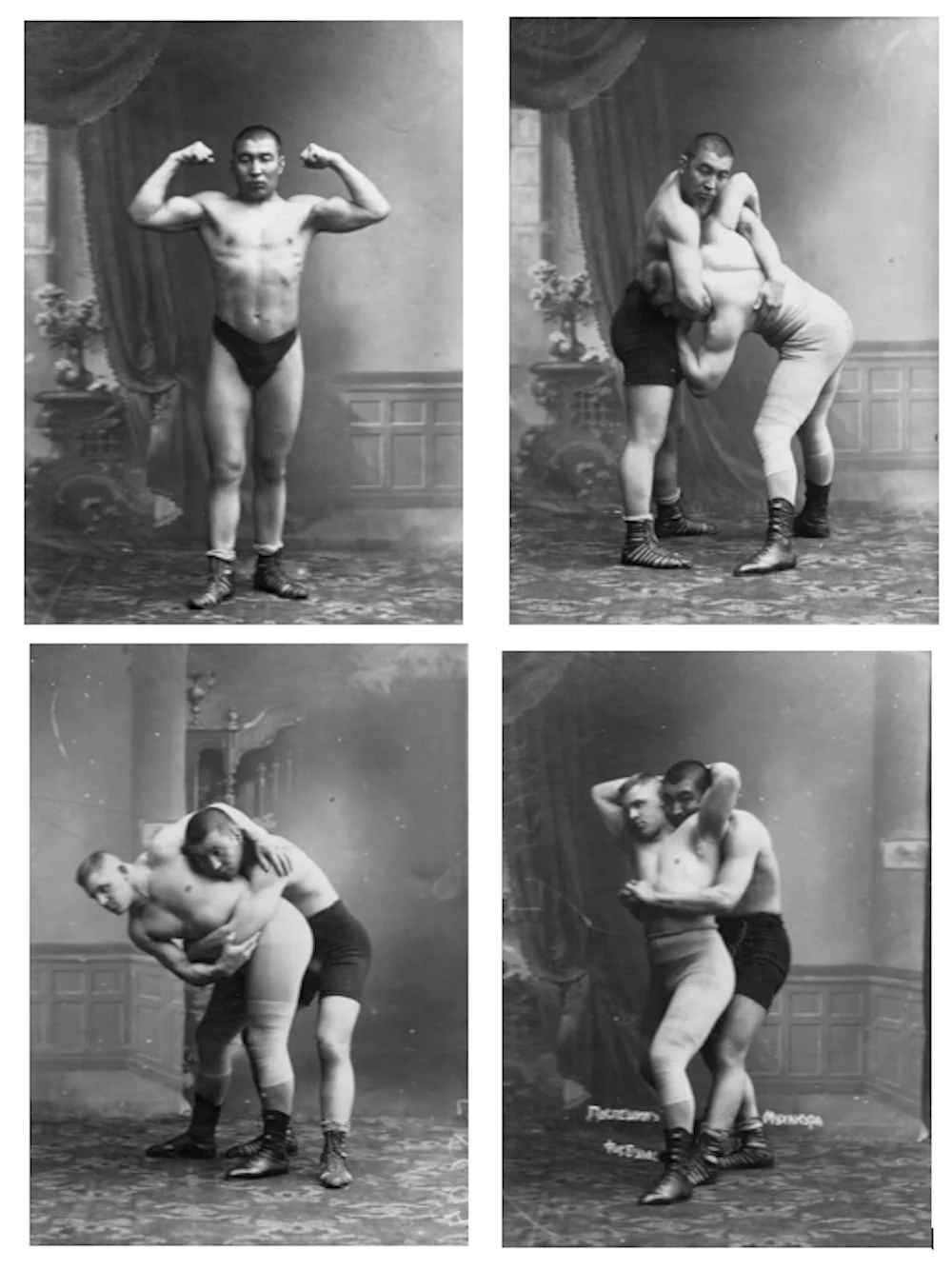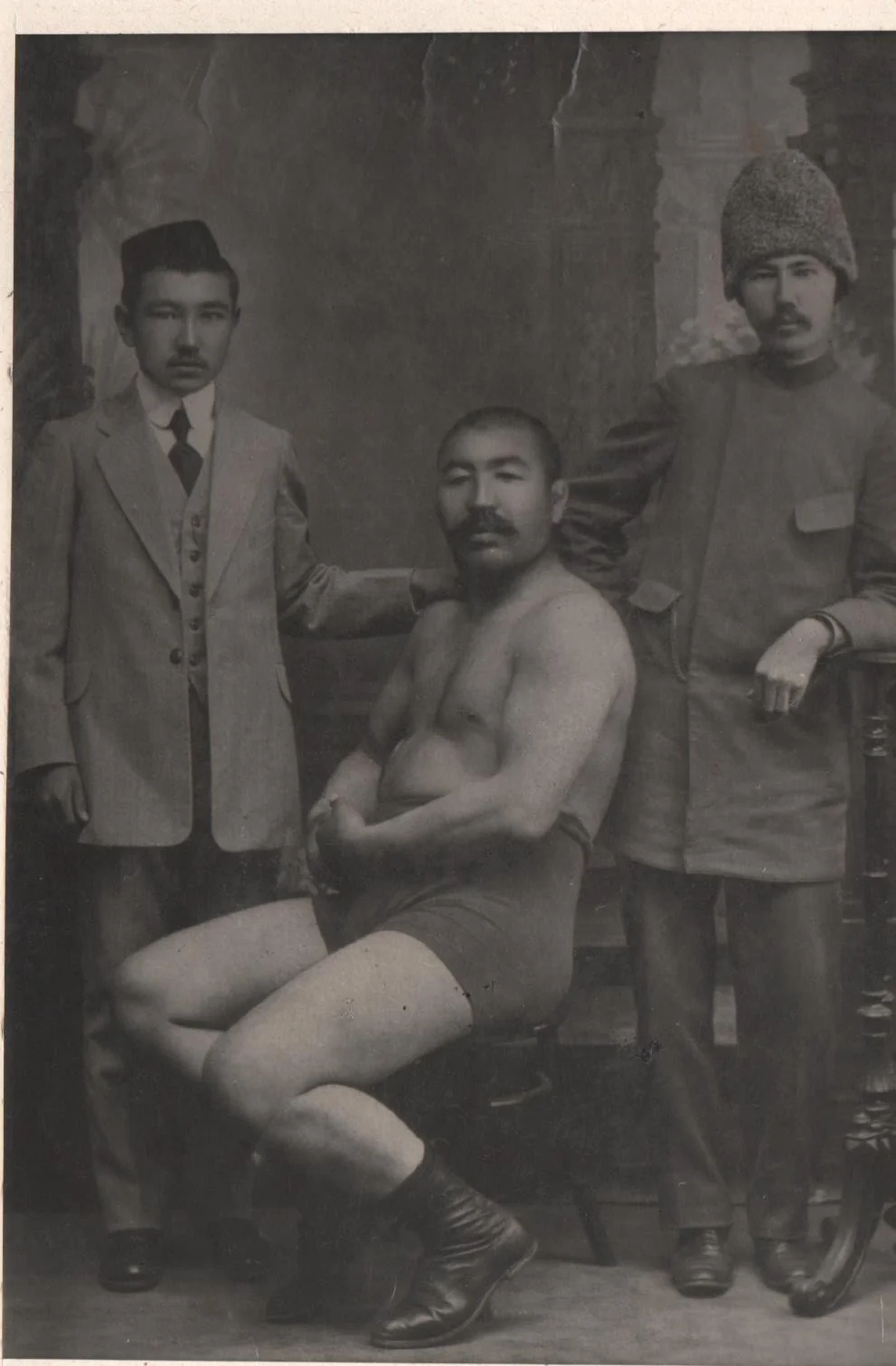At the beginning of the twentieth century, a time when soccer had not yet become the world’s favourite sport, basketball was just beginning to take off, and the Olympic Games included not only athletic competitions but also literary, sculptural, and musical contests, wrestling was undoubtedly the most popular and entertaining sport globally.
Wrestling, unlike hockey and tennis, was played by everyone, everywhere, on all continents. It was popular, but unlike gymnastics, it was spectator-friendly, attracting thousands of fans around the world. A wrestling match often became a truly international show, with wrestlers from all over the world, from different cultures and wrestling schools, competing against each other. Even during times of war and confrontation, famous wrestlers continued to travel the world to entertain local audiences.

Kazhimukan Munaytpasov in Omsk in 1918/egemen.kz
Before the advent and spread of television, few people knew these heroes by sight, but their names alone were often enough to fill a huge hall for a match with a local champion. And it was at this time that the public in various cities around the world, from Harbin to Paris, began to talk about the stars of professional wrestling: Yamagata Muhanura, the champion of Japan, Korea, and Manchuria; Black Ivan from Russia; the fearless Turk Kara Mustafa; and the mysterious wrestler known as the ‘Red Mask’. Bear in mind that this was long before the practice of wrestling names became popular in American wrestling. It may have been worth trying to gather all these wrestlers from different parts of the world for one tournament if not for one important detail—they were all one and the same person! You see, the Kazakh wrestler Qajymuqan Munaitpasov performed under these pseudonyms, using them to conquer professional wrestling competitions in Paris and all over the world. He became the first Kazakh world champion in ‘French wrestling’ exactly 115 years ago.

Kazhymukan's personal photo and several photos of him with Czech wrestler Karl Poshpeshil demonstrating wrestling techniques/egemen.kz
Qajymuqan Munaitpasov’s life and his stage and sports images have always been shrouded in legend, to which he, a talented showman and storyteller, contributed a great deal. Muqan Munaitpasuly was born in the village of Karaötkel in the Akmola province of the Russian Empire, which is located so close to the modern capital of Kazakhstan that it has become one of its suburbs. Qajymuqan was said to be a direct descendant of the legendary Kobylandy Toktarbayuly (Qobylandy Batyr), the hero of the epic of the same name often associated with the founding of the Kazakh Khanate.

Photo of Kazhymukan Munaitpasov with beard in a cape/egemen.kz
Munaitpasov, the first Kazakh professional wrestler, began in the sport at an early age and was honored with a catchy wrestling nickname ‘Bala Baluan’ (child wrestler). He started practicing qazaqsha kùres (Kazakh wrestling), an ancient and traditional type of wrestling common in the Kazakh steppe, and he was taught its intricacies by his grandfather. However, he later became popular not as the winner of regional Kazakh wrestling tournaments but as a circus wrestler. Such performances were an important part of circus shows, and having started his professional career in the circus, he made his debut in 1901 in Omsk, specializing in French wrestling. Here he fought the experienced Andrei Zlobin, who later encouraged the young Kazakh to join Ivan Lebedev’s (known as Uncle Vanya) wrestling school in St. Petersburg.

A photo of Kazhymukan Munaitpasov with the famous Estonian wrestler Karl Tomberg holding special fake accessories (wine, glass, etc.) in a photo salon/egemen.kz
It was Lebedev, an eager and ambitious promotor, who helped craft Munaitpasov’s stage personas. He helped transform the Kazakh wrestler into the Japanese samurai and emperor’s bodyguard Yamagata Muhanura, the Red Mask, and the Turkish giant Kara Mustafa. He also performed under the pseudonym ‘Black Ivan’, which he inherited from a team consisting of himself and three other Ivans: Poddubny, Zaikin, and Shemyakin.
The young Kazakh wrestler achieved his first international success after a brilliant performance in Harbin, where he won a gold medal in the jiu-jitsu championship, although he had previously practiced only Kazakh and French wrestling. This earned him the title ‘Champion of Manchuria’, which was often associated with his Japanese alter ego. In 1909, in Götheborg, Sweden, he officially became the world champion of French professional wrestling, paving the way for future world and Olympic champions from Kazakhstan.

Munaitpasov Kazhimukan/gov.kz
What was then called ‘French wrestling’ was classical wrestling, now known as the Greco-Roman style. It was rightly considered the most powerful and graceful of all the forms, and as the name implies, Paris was considered the Mecca for all great wrestlers. Qajymuqan, who had won world championships in 1908, 1909, 1911, and 1913, won his last championship in Paris in 1914, although he had won important tournaments in the city before. Once, in Paris, Qajymuqan refused to fight his close friend Ivan Poddubny in the final match, citing respect for his ‘older brother’, whom he had known since the days of the Omsk circus.
Qajymuqan always remained a great Kazakh patriot and philanthropist as well as a spiritual man. During his long tour in the capital of the Ottoman Empire, he defeated the 175-kilogram Turkish champion Nurullah and was so favored by the famous Ottoman general Mehmed Şakir Pasha that, after a brief conversation with the Kazakh wrestler, Şakir Pasha offered to make the Hajj, the holy pilgrimage to Mecca, with him. After that, the whole world knew Muqan from Karaötkel as Qajymuqan, or Muqan the Pilgrim.

Khajimukan Munaitpasov (standing in the center), Kokbai Kunanbayev (Abai's brother, sitting in the center), Turagul Ibragimov (sitting second from left, Abai's son), Mirzhakip Dulatov (fourth from right in a light), Akhmet Baitursynov (far right) and other representatives of the Kazakh intelligentsia. 1918/Wikimedia Commons
Qajymuqan was married four times, and his first wife was a Polish woman named Nadieżda Czepkowska, who also performed in the circus. After their wedding, she converted to Islam and took the Kazakh name Batima. As it turned out later, he had children outside these marriages, including one with a French woman—indeed, his long stints in Paris left a family trail too.
After the October Revolution, and especially after the fall of Alash Orda, Qajymuqan, a close friend of many leaders of the Alash movement and a supporter of their political actions, found himself a target of persecution. Despite this, many writers of the Soviet period portrayed him in fiction as an ardent Bolshevik and an opponent of Kazakh national autonomy. For a long time he fought for the lives of his oppressed relatives and friends, and was the only person allowed to visit Aidarkhan Tu̇rlybayev, one of the leaders of Alash Orda and the organizer of its military units, in prison before he was executed.

Munaitpasov Kazhimukan/Wikimedia Commons
Despite the fact that his professional sports career was far behind him, Qajymuqan continued to attract audiences to his performances and raised money for charity well into his old age. In 1944, during the Second World War, the seventy-year-old wrestler collected 100,000 rubles through his shows, and this money was used to buy a U-2 plane named to honor the Kazakh hero Amangeldy Imanov. Interestingly, this plane, piloted by a young Kazakh named Qajytai Shalabayev, fought throughout the war and made 217 combat sorties.
Qajymuqan Munaitpasov’s tale in history told of him being not only a great and invincible fighter but also a great lover of the arts. From the earliest days of his circus performances, he participated in humorous sketches, sang, and played the dombra beautifully. In 1926, he opened the first Kazakh professional theater in the then Kazakh capital of Kyzylorda and even took part in some performances. In 1927, he officially received the honorary title ‘Batyr of the Kazakh People’. Unsurprisingly, another conqueror of Paris, the famous Kazakh singer Amre Qashaubayev, also performed there.

